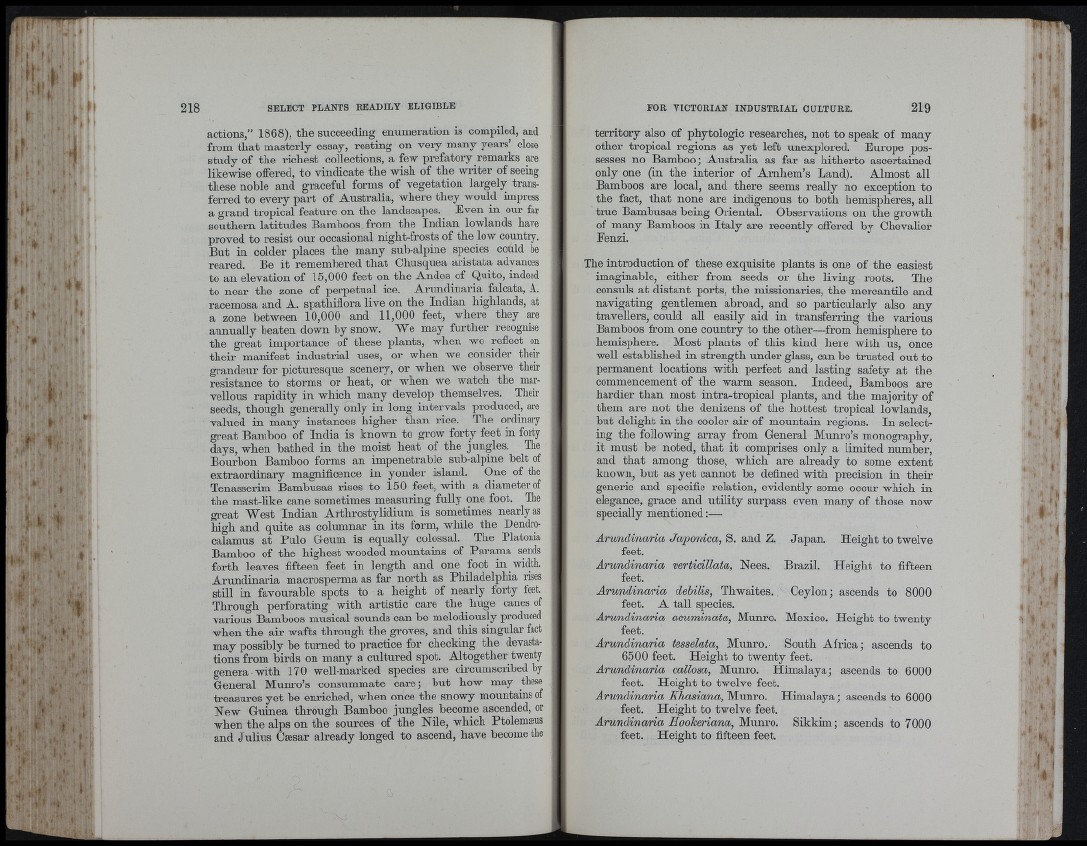
' I ‘
actions,” 1868), the succeeding enumeration is compiled, and
from that masterly essay, resting on very many years’ close
study of the richest collections, a few prefatory remarks are
likewise offered, to vindicate the wish of the writer of seeing
these noble and graceful forms of vegetation largely transferred
to every part of Australia, where they would impress
a grand tropical feature on the landscapes. Even in our far
southern latitudes Bamboos from the Indian lowlands have
proved to resist our occasional night-frosts of the low country.
But in colder places the many sub-alpine species could be
reared. Be it remembered th a t Chusquea aristata advances
to an elevation of 15,000 feet on tbe Andes of Quito, indeed
to near tbe zone of perpetual ice. Arundinaria falcata, A,
racemosa and A. spathiflora live on the Indian highlands, at
a zone between 10,000 and 11,000 feet, where they are
annually beaten down by snow. We may further recognise
tbe great importance of these plants, when we reflect on
their manifest industrial uses, or when we consider then
grandeur for picturesque scenery, or when we observe tlieir
resistance to storms or beat, or when we watch the marvellous
rapidity in which many develop themselves. Their
seeds, though generally only in long intervals produced, are
valued in many instances higher than rice. Tbe ordinary
great Bamboo of India is known to grow forty feet in forty
days, when bathed in the moist heat of the jungles. The
Bourbon Bamboo forms an impenetrable sub-alpine belt of
extraordinary magnificence in yonder island. One of the
Tenasserim Bambusas rises to 150 feet, with a diameter of
the mast-like cane sometimes measuring fully one foot. The
great West Indian Artbrostylidium is sometimes nearly as
bigb and quite as columnar in its form, while tbe Dendro-
calamns at Pulo Geum is equally colossal. Tbe Platonia
Bamboo of tbe highest wooded mountains of Parama sends
forth leaves fifteen feet in length and one foot in width.
Arundinaria macrosperma as far north as Philadelphia rises
still in favourable spots to a height of nearly forty feet.
Through perforating with artistic care tbe huge canes of
various Bamboos musical sounds can be melodiously produced
when the air wafts through tbe groves, and this singular fact
may possibly be turned to practice for checking the devastations
from birds on many a cultured spot. Altogether twenty
genera with 170 well-marked species are circumscribed by
General Munro’s consummate care; but bow may these
treasures yet be enriched, when once the snowy mountains of
New Guinea through Bamboo jungles become ascended, or
when tbe alps on the sources of the Nile, wbich Ptolemseus
and Julius Csesar already longed to ascend, have become the
territory also of phytologic researches, not to speak of many
other tropical regions as yet left unexplored. Europe possesses
no Bamboo; Anstralia as far as hitherto ascertained
only one (in the interior of Arnhem’s Land). Almost all
Bamboos are local, and there seems really no exception to
the fact, that none are indigenous to both hemispheres, all
true Bambusas being Oriental. Observations on the growth
of many Bamboos in Italy are recently offered hy Chevalier
Eenzi.
The introduction of these exquisite plants is one of the easiest
imaginable, either from seeds or the living roots. The
consuls at distant ports, the missionaries, the mercantile and
navigating gentlemen abroad, and so particularly also any
travellers, could all easily aid in transferring the various
Bamboos from one country to the other—from hemisphere to
hemisphere. Most plants of this kind here with us, once
well established in strength under glass, can be trusted out to
permanent locations with perfect and lasting safety at the
commencement of the warm season. Indeed, Bamboos are
hardier than most intra-tropical plants, and the majority of
them are not the denizens of the hottest tropical lowlands,
but deligbt in tbe cooler air of mountain regions. In select-
mg tbe following array from General Munro’s monograpby,
it must be noted, tb a t it comprises only a limited number,
and tb a t among tbose, wbich are already to some extent
known, but as yet cannot be defined with precision in theii’
generic and specific relation, evidently some occur which in
elegance, grace and utility surpass even many of those now
specially mentioned:—
Arundinaria Japónica, S. and Z. Japan. Height to twelve
feet.
Arundinaria vcrticillata, Nees. Brazil. Height to fifteen
feet.
Arundinaria dehilis, Thwaites. Ceylon; ascends to 8000
feet. A tall species.
Arundinaria acuminata, Munro. Mexico. Height to twenty
feet.
Arundinaria tcsselata, Munro.- South Africa; ascends to
6500 feet. Height to twenty feet.
Arundinaria callosa, Munro. Himalaya; ascends to 6000
feet. Height to twelve feet.
Arundinaria Khasiana, Munro. Himalaya; ascends to 6000
feet. Height to twelve feet.
Arundinaria Hookeriana, Munro. Sikkim; ascends to 7000
feet. Height to fifteen feet.
t '
[ '
¥ ;